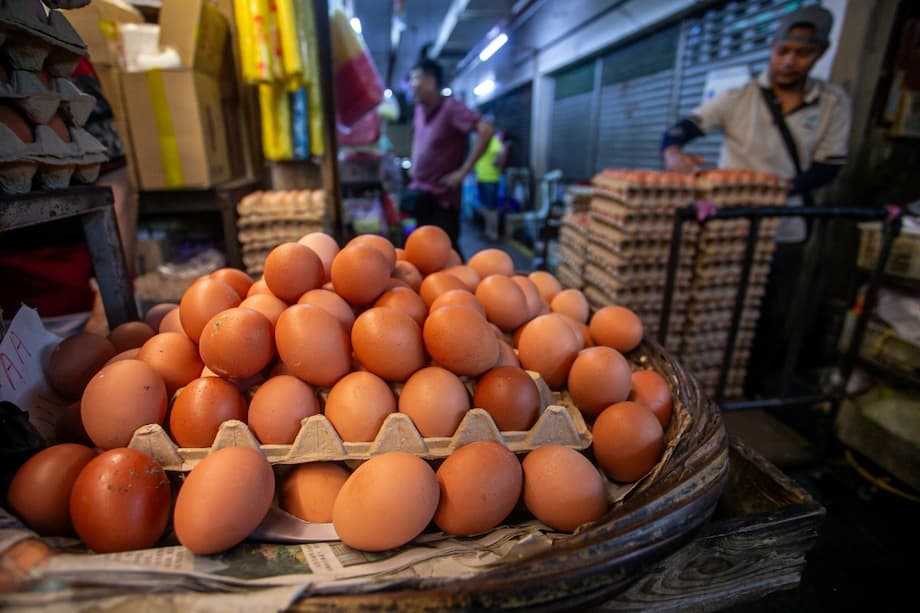Why eggs cost more now
In the month after Malaysia ended subsidies and price controls for chicken eggs on August 1, small food traders from Johor Baru to Bintulu reported thinner margins and difficult choices on menu prices. A roadside takoyaki seller in Johor Baru said a tray that cost about RM9 earlier in the year now sells for around RM12.99. Kopitiam owners and caterers who use eggs in large volumes are holding prices steady for now, but many say they will have to review menus if costs keep rising. This squeeze is a sharp turn from 2024, when the government briefly cut retail prices by about 3 sen per egg in the peninsula after feed costs eased. The shift reflects a policy pivot toward market pricing and targeted assistance, with the government highlighting the need to curb broad subsidies and save public funds after spending roughly RM2.5 billion on eggs since early 2022.
- Why eggs cost more now
- How small traders are coping in Johor and beyond
- Are retail prices really rising
- Feed costs, currency, and the supply chain behind an egg
- Sabah and Sarawak face higher prices and thinner supply
- What the government says and what enforcement can do
- Industry outlook and the business side
- Lessons from shortages and global shocks
- What shoppers and small businesses can do now
- What to Know
Officials said the removal of the 10 sen per egg subsidy would likely raise prices by a small amount, with estimates ranging from about 2 to 4 sen per egg. Some traders on the ground say their actual purchase prices have climbed more than that, depending on grade, location, and supply conditions. Sarawak and Sabah tend to see higher retail prices than the peninsula, and traders in some districts report inconsistent stock. These variances help explain why small businesses are feeling the pinch even if headline averages look steady in certain cities.
The underlying driver is the cost of feed, primarily corn and soybean meal, which Malaysia imports in large quantities. Feed commonly accounts for around 70 percent of production costs for egg farmers. Global disruptions since 2022, including the Russia Ukraine war and bouts of avian influenza in poultry markets, pushed feed costs up and forced smaller producers to scale back. A stronger or weaker ringgit also matters, since feed is priced in dollars. When feed costs ease, prices tend to stabilize. When feed rises, pressure builds quickly along the chain from farms to hawker stalls.
How much of a price rise is expected
Before the subsidy ended, ceiling prices ranged from 38 to 42 sen per egg depending on grade. Analysts cited in regional media anticipated a modest rise of around 3 sen per egg once the market floated. Market surveys in May and June, after the subsidy was halved from 10 sen to 5 sen, found many retailers had not yet moved prices while working through existing stock. That picture can lag reality for small vendors who buy more frequently or from wholesalers with tighter supplies. Evidence from Johor Baru and other cities suggests some traders are already paying higher tray prices and are absorbing the difference to avoid losing price sensitive customers.
How small traders are coping in Johor and beyond
The strain is clearest for micro businesses that depend on eggs as a daily input. A Johor Baru takoyaki seller who uses about 15 Grade B eggs each day has held prices steady even as flour and cooking oil costs have ticked up. The result is a smaller take-home income. A kopitiam owner with two outlets is using roughly three trays a day and is trying to keep meals affordable for regulars, but has signaled that a menu review may be unavoidable if costs climb again. A caterer who moves about 15 crates daily said large party orders are the hardest to price because customers react quickly to any change in portion size or per-head cost.
Menu changes and margins
Some operators are rewriting recipes to stretch their egg use without compromising quality. That can mean tweaking batter ratios, substituting an extra vegetable in fried rice orders, or switching to smaller portions for egg-based desserts. When customers set a strict budget, caterers sometimes cut the number of eggs in a dish to keep the bill unchanged. The trade-off is a narrower margin for the operator and, at times, a leaner plate for the customer.
Why raising prices is risky
Hawker stalls and small cafes compete in a crowded market where even a small increase can send diners to a rival down the street. Traders fear that a quick adjustment could drive away regulars or trigger social media criticism. Many would prefer a period of stable wholesale prices so they can plan menus and batch purchases. Several operators have called for closer monitoring of wholesale price movements, particularly during periods of policy change, so that retail prices do not whipsaw from week to week.
Are retail prices really rising
Reports from several cities indicate a mixed picture. In Kuala Lumpur, some retailers said prices had stayed flat as they cleared older stock, and expected any increase to be small if supply remained smooth. In Perlis and Sabah, grocers said they were waiting to see how new shipments would be priced. Government enforcement teams have continued inspections to deter unjustified markups, and state officials warned they would intensify checks if prices drifted above reasonable ranges.
Lee Chun Sian, who runs a stall at the Raja Bot Market in Kuala Lumpur, said supply was the key determinant of stability. He described steady prices while working through existing stock.
Even without subsidies, prices should not go up much if the supply is consistent.
Madam Wong, another Kuala Lumpur trader, said store owners were watching closely for any sign of unjustified markups and would weigh customer sentiment before raising prices.
We have received the new pricing list, but we will meet next week to decide if a price revision is necessary. If we raise them too much, customers will complain.
Shopper Nurul Othman urged consumers to stay calm and avoid emptying shelves. Panic buying can turn a manageable adjustment into a real shortage.
It is panic buying that disrupts supply. There is no need to hoard, just buy as usual.
Why some traders feel more pain than others
Location, purchasing scale, and timing explain most of the variation. A grocer or supermarket that buys in bulk can lock in a better rate and move slower on retail changes. A street vendor who buys small quantities more frequently absorbs price swings in real time. Distance from main distribution hubs also matters. Retail prices in Sabah and Sarawak often sit above those in Peninsular Malaysia due to transport and logistics costs.
Feed costs, currency, and the supply chain behind an egg
Malaysia’s egg prices are linked to global commodity markets. Farmers import most of their corn and soybean meal. When war or weather disrupts harvests in major exporters, or when shipping costs jump, feed prices rise. The Russia Ukraine conflict restricted some grain flows and lifted prices, which filtered into higher production costs. Episodes of avian influenza in poultry markets can restrict regional supply and increase trade frictions.
Commodity cycles add another layer. When world demand for meat rises, more feed is required to grow animals, which lifts grain prices. Biofuel policies can divert corn and vegetable oils into energy markets, tightening supply for food use. Currency movements are powerful too. A weaker ringgit makes feed more expensive, even if global prices are stable. When the ringgit strengthens, it can soften feed costs for importers and create room for farmers to hold ex farm prices steady.
Why 2023 shortages mattered
In late 2022 and early 2023, Malaysia experienced tight supply and even imported eggs from India to stabilize the market. Indian hatcheries shipped tens of millions of eggs in a matter of months, helping prices retreat from record levels. That episode showed how quickly cross border trade can close a shortfall, but also how dependent egg markets are on conditions outside Malaysia’s control. When nearby suppliers fight disease outbreaks or face their own cost spikes, imports become harder to secure.
Sabah and Sarawak face higher prices and thinner supply
Small businesses in Sarawak, including childcare centers that rely on eggs as a low cost protein, warned that the phase out of subsidies would worsen already higher prices in the state. Operators in Bintulu described Grade B trays priced far above levels in the peninsula, and said even small increments per egg had an outsized impact on weekly budgets for feeding children. Grocers reported that regular eggs are sometimes scarce, with premium lines like selenium enriched and organic eggs more available but expensive.
That local reality can diverge from national averages, which are shaped by Peninsular Malaysia’s larger and more competitive market. Transport, storage, and distribution paths across rural parts of Sabah and Sarawak add costs. If wholesalers prioritize urban centers with faster turnover, smaller towns may see thinner stock and sharper price moves.
What the government says and what enforcement can do
The Agriculture and Food Security Ministry framed the subsidy removal as a step taken after supply stabilized and production costs eased from peaks. Officials argued that a floating price better reflects true costs and supports a sustainable industry. They projected a modest increase per egg and stressed continued monitoring. The Domestic Trade and Cost of Living Ministry has maintained checks at wet markets and supermarkets, with state level leaders saying enforcement will intensify if unjustified hikes appear. Some states and agencies continue to run special sales that offer below market prices for essential goods, including eggs, to ease pressure on households.
Tax policy has also been tuned to limit pressure on basics. The Ministry of Finance emphasized that daily essentials, including eggs, are not subject to Sales Tax. Authorities revised elements of the Sales and Service Tax expansion in mid 2025 after public feedback, raising thresholds for some services and clarifying exemptions to spare micro and small businesses unnecessary cost. Targeted aid programs, such as credits for low income households to buy essentials, have also cushioned some families from price increases.
Calls from small operators
Small traders want steady wholesale prices, more granular monitoring of regional differences, and clear guardrails against sudden jumps. Several have said blanket subsidies provided temporary relief but did not prevent abrupt swings tied to global feed costs. Many welcome predictable pricing more than subsidies that switch on and off, which makes planning difficult. They also ask for help upgrading storage and logistics, so they can buy in larger batches when prices are favorable without compromising freshness.
Industry outlook and the business side
Large poultry companies have reported better margins during periods of lower feed costs. In 2024, several listed producers booked strong earnings even as share prices softened on concerns about the end of blanket subsidies. Research houses pointed out that producers can remain profitable without subsidies if feed costs stay contained and the ringgit is stable. The risk is a renewed feed spike. If corn and soybean meal climb, producers will seek higher ex farm prices to protect margins, and the pressure will spill over to retailers and food outlets.
Malaysia’s egg production has grown, with official data indicating output of about 16.7 billion eggs in 2023 and a self sufficiency ratio above 100 percent. Annual consumption is roughly 11.6 billion units. In theory, that surplus provides a buffer, but distribution and cost issues can still cause local tightness. When policy shifts, the adjustment period matters for small traders who buy daily and have thin cash flow. Market based pricing can promote investment and efficiency in the long run, yet it requires vigilant enforcement against collusion or unjustified hikes and clear communication so retailers can plan stock and prices.
Lessons from shortages and global shocks
The past three years showed how external shocks travel through egg markets. War affected grain shipments, disease outbreaks hit flocks, and tariff moves jolted trade flows. In early 2025, new tariffs in major economies shook global markets. If such measures reduce global poultry trade or shift demand, they can alter the cost structure for producers worldwide. While Malaysia does not rely on the United States for egg imports, broader trade tensions can move feed prices and freight costs, eventually influencing retail prices in local markets.
During the height of shortages in 2023, Malaysia tapped Indian supply quickly, demonstrating the value of flexible import options and established relationships with multiple producers. Academic studies of global egg trade networks show denser, more connected flows across regions. That connectivity helps cushion shocks, yet it also means local prices are exposed to events far beyond national borders. For a staple like eggs, which serve as an affordable protein for low and middle income households, the combination of domestic resilience and diverse import channels remains critical.
What keeps prices steady
Prices tend to settle when three conditions hold: feed costs are stable, disease outbreaks are under control, and distribution is smooth from farm to retail. Government actions that support those conditions include surveillance against avian influenza, transparent reporting on feed market trends, and targeted support where transport and storage are weak. Retail inspections deter unjustified markups, and public messages that discourage hoarding keep shelves stocked.
What shoppers and small businesses can do now
Consumers can reduce waste and plan purchases to match actual needs, which helps prevent temporary shortages. Where special sales offer lower prices, households can buy a tray and share with neighbors rather than hoard. Small operators can smooth costs by pooling purchases with nearby stalls, exploring alternative grades when quality is comparable, and investing in storage that maintains freshness for a few extra days. Menu engineering helps too. A cafe might feature dishes that use fewer eggs when weekly prices spike, then rotate back when costs ease.
Communication with customers matters. When a stall explains that an extra 10 sen per egg translates to RM3 per tray, diners better understand a small change in menu prices. Transparent pricing builds trust, especially when operators also point to periods when they held prices despite rising costs. Traders can also watch feed market signals and exchange notes with suppliers to time purchases.
What to Know
- Malaysia ended the 10 sen per egg subsidy and price controls on August 1, after spending about RM2.5 billion on egg support since 2022.
- Small traders in Johor Baru and other cities report higher tray prices and tighter margins, with many delaying menu increases to retain customers.
- Officials projected a modest price lift of about 2 to 4 sen per egg, but actual retail changes vary by region, grade, and supply conditions.
- Feed costs, which make up around 70 percent of production, remain the main driver. Corn and soybean meal are imported and sensitive to global prices and currency moves.
- Sabah and Sarawak often face higher retail prices due to logistics and thinner stock, heightening the strain on childcare centers and small businesses.
- Enforcement teams continue market checks, while essential goods like eggs are exempt from Sales Tax. Some states hold special sales to ease household budgets.
- Malaysia’s production reached about 16.7 billion eggs in 2023, above domestic needs, but distribution and cost issues can still create local tightness.
- Global shocks, including war, disease outbreaks, and trade tensions, can move feed and freight costs that filter into local egg prices.




